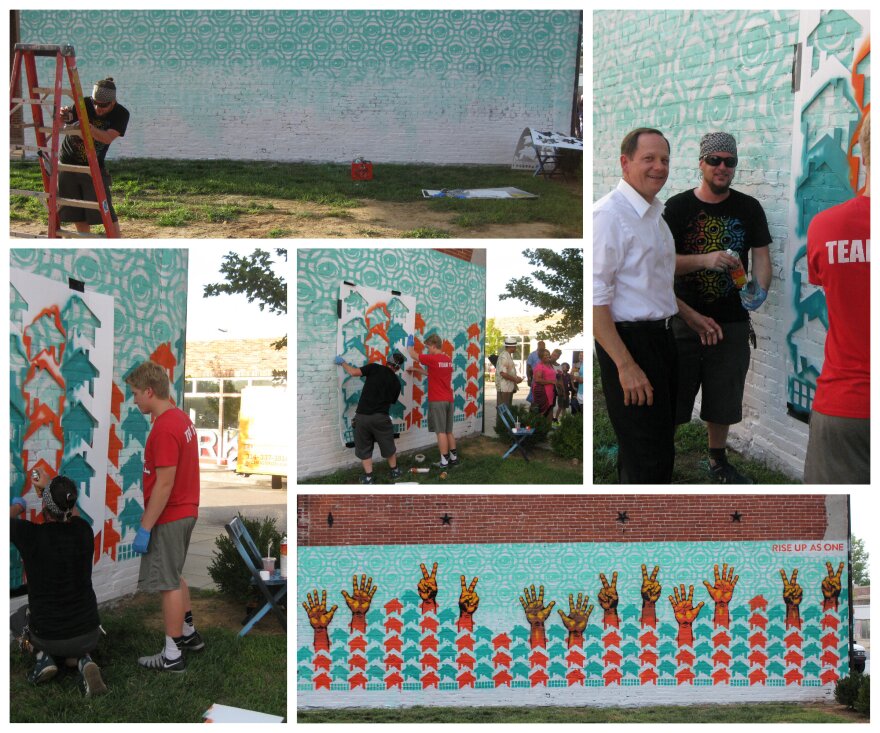Fifteen years ago, the area of St. Louis now known as The Grove was a place many people avoided.
“It was ‘Roll up your window and drive really fast,’” muralist Grace McCammond remembered.
By 2004, things were getting better, but the area teetered precariously on the edge of revitalization. Novak’s bar had just moved across from the longstanding Attitudes but Atomic Cowboy was yet to emerge as the anchor for the east end of Manchester Avenue at Vandeventer. A few blocks west, the high-end Jaboni’s Bistro — ahead of its time, many said — would soon close, as would the ice cream shop that would reopen as the renowned Sweetie Pie’s.

Murals tell the story of what happened next. Owners of the Boldt Brothers building, between Attitudes and Just John nightclubs, started the trend by commissioning McCammond to paint a muted tribute to window washers, the first artistic stepping-stone along the now-prolific path of painted brick walls that would soon mark the rise of The Grove as a popular, edgy hotspot.
Atomic Cowboy's owners liked what they saw, and wanted one too. Their now iconic rocket-riding cowgirl led the way to more and more such projects, and today, several dozen McCammond murals — both artistic and commercial — dot the bustling strip, which boasts some 60 restaurants, music venues, bars and other operations, interrupted by a dwindling collection of vacant buildings.
“Murals build a sense of community,” McCammond said. "They make it welcoming and walkable and they make you want to go there."
Helping children take ownership — and dream
The newest Grove mural is on the side on the Gramophone music venue building. It was all but completed this past weekend, with the help of residents and other Grove enthusiasts, during the tenth annual Grove Fest.

It’s a paint-by-number project, something McCammond instituted at the first such street festival in 2005.
“We needed something for the kids,” McCammond noted. “Now, people from two years old to 80 participate.”
Every year, these murals unite participants from all walks of life.
“There are very diverse people standing next to each other, painting and communicating,” McCammond said. “So for 15 or 20 minutes, they have a conversation: ‘Where does your kid go to school, what do you do?’”
Two other Grove murals have been completed with help from the Herbert Hoover Boys and Girls Club.
These include a wall of faces of famous St. Louis African-Americans and the Groovin’ in the Grove display. Making murals helps children who live in the area to take ownership of the gentrification of their neighborhood, according to Matt Green, administrator of The Grove Community Improvement District.
“They get the chance to contribute to the facelift, the improvements, the beautification of the district,” Green said.

Local artist Cbabi Bayoc, known for his portraits of involved African-American fathers, also understands the ways in which murals can uplift children. In August, he completed a colorful mural on the side of the Kingdom House, an organization near Lafayette Square dedicated to bringing people out of poverty. African-American students of historically black colleges and universities attending a leadership conference came to help.
The mural is meant to inspire neighborhood children, who were recently taken to see the Arch. Even though they can almost see the St. Louis monument from their neighborhood, the overwhelming majority had never visited it.
“So the idea that we agreed on was ‘Dream Big,’” Bayoc said. “The mural has kids doing different things: being a scientist, a dancer, all telling them to dream big and go for it.”
So what is Bayoc’s dream? To create a black fathers mural on the old Sears building on Kingshighway near Natural Bridge Road.
“So many young men are roaming around, directionless, and I think it would be good to see a strong image, to let folks know they are of value,” Bayoc said.
Nod to Ferguson
Murals can brighten a dull spot in even a thriving community. Recently, the Screwed Arts Collective finished a vibrant quilt mural in St. Louis’ Dutchtown.

This summer, STL Mural Project completed a tribute to innovation on Washington Avenue’s Monkey Building.
Murals also have the power to promote healing. St. Louis stencil artist Peat Wollaeger was in the planning stages of a community-participation mural to celebrate Crown Square in North St. Louis in a Rise Up festival this past August, when Ferguson police officer Darren Wilson shot and killed unarmed teenager Michael Brown.
The original blueprint consisted of homes and upturned arrows, “Like a community rising,” Wollaeger said.
After the Ferguson tragedy and its aftermath, Wollaeger decided to add upraised hands, some flashing peace signs. It’s a nod, not a pointed reference. (Article continues after the collage.)

“If it were something I was doing that was not so community-based, I probably would be more straightforward with it,” Wollaeger said. “I have to keep in mind this is a public mural that will be up for a long time.”
Wollaeger’s seen murals revitalize communities around the country. He participated in a mural project in a declining area of Miami.
“Now, there are probably 200 different murals in that neighborhood, and it’s now a massive hot spot. Everybody goes there to be around this crazy, awesome public art,” Wallaeger said.
Wollaeger sees St. Louis poised for an explosion of mural activity that cities like Miami, New York and San Francisco have already experienced.
“St. Louis is sometimes about five years behind the curve,” Wollaeger said.
Murals reveal and make us feel
Mural artist Faring Purth from Oakland, CA, also sees St. Louis positioned for an influx of murals — and international mural artists like herself. She came to town in February on the recommendation of a friend, and fell in love with St. Louis, even though not everyone in St. Louis loved her back.

Purth’s first local mural, called “Prime,” depicts a nearly nude woman, crouching on the long wall of a building that houses a Family Dollar store and a nail salon. It drew criticism that was even noted by a national publication.
Purth’s second St. Louis mural is displayed on the side of the Sanctuaria restaurant building in The Grove. But before she could finish, her work was marred by the crude graffiti of vandals. Several weeks later, Purth put the incident into perspective.
“The power of art is that it can reveal something,” Purth said.
The damage reveals more about the perpetrators and the city than the work, she said. Perhaps it stirred something inside the vandals. Perhaps there was resentment that an out-of-town artist landed such a big project.

Purth still maintains a residence in St. Louis and would like to perhaps paint one more mural here. She believes in public art as a way to eliminate the walls of a museum or gallery, and the barriers of class, gender and other divisions. Such museum-quality outdoor art helps people stay in touch with who they are, she said.
“Murals allow people to stand still and truly feel, instead of zoning out and working their 9-5 jobs and trying to get home,” Purth said. “It allows them to stop and feel whatever they need to feel in that moment.”
Follow Nancy Fowler on Twitter: @NancyFowlerSTL








